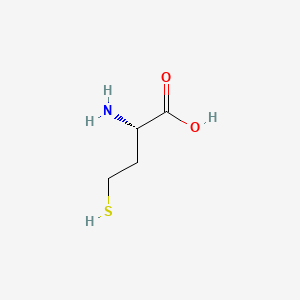Ferroptosis-centered Drug Response Information
General Information of the Drug (ID: ferrodrug0143)
| Name |
L-Homocysteine
|
||||
|---|---|---|---|---|---|
| Synonyms |
L-Homocysteine; homocysteine; 6027-13-0; (s)-2-amino-4-mercaptobutanoic acid; (2S)-2-amino-4-sulfanylbutanoic acid; 2-AMINO-4-MERCAPTO-BUTYRIC ACID; CHEBI:17588; L-2-Amino-4-mercaptobutyric acid; 0LVT1QZ0BA; CHEMBL469662; Hcy; homo-cys; 454-28-4; Homocysteine, L-; Butyric acid, 2-amino-4-mercapto-; MFCD00151320; HCS; Homocysteine (VAN); UNII-0LVT1QZ0BA; (S)-2-Amino-4-mercaptobutyric acid; 2-amino-4-sulfanylbutanoate; NSC-43117; NSC-118376; EINECS 227-891-0; NSC 43117; H-Hcys-OH; NSC 118376; 2-Amino-4-mercaptobutyric acid (VAN); Butyric acid, 2-amino-4-mercapto-, L-; (S)-HOMOCYSTEINE; Butanoic acid, 2-amino-4-mercapto- (VAN); HOMOCYSTEINE [MI]; Butanoic acid, 2-amino-4-mercapto-, (S)-; Epitope ID:143650; SCHEMBL35837; 2-amino-4-mercapto-Butanoate; GTPL5198; DTXSID3041039; 2-amino-4-mercapto-DL-Butyrate; 2-amino-4-mercapto-Butanoic acid; FFFHZYDWPBMWHY-VKHMYHEASA-N; (S)-2-amino-4-mercapto-Butanoate; L-2-amino-4-mercapto-Butyric acid; (s)-2-amino-4-mercaptobutanoicacid; 2-amino-4-mercapto-DL-Butyric acid; BDBM50242405; DL-2-amino-4-mercapto-Butyric acid; L-Homocysteine, >=98.0% (NT); AKOS006272166; (S)-2-amino-4-mercapto-Butanoic acid; CS-W011063; DB04422; FS-6405; HY-W010347; C00155; H-2800; I11579; A832662; Q26992833
Click to Show/Hide
|
||||
| Status |
Investigative
|
||||
| Drug Type |
Small molecular drug
|
||||
| Structure |
 |
||||
| Formula |
C4H9NO2S
|
||||
| IUPAC Name |
(2S)-2-amino-4-sulfanylbutanoic acid
|
||||
| Canonical SMILES |
C(CS)C(C(=O)O)N
|
||||
| InChI |
InChI=1S/C4H9NO2S/c5-3(1-2-8)4(6)7/h3,8H,1-2,5H2,(H,6,7)/t3-/m0/s1
|
||||
| InChIKey |
FFFHZYDWPBMWHY-VKHMYHEASA-N
|
||||
| PubChem CID | |||||
Full List of Ferroptosis Target Related to This Drug
Phospholipid hydroperoxide glutathione peroxidase (GPX4)
| In total 1 item(s) under this Target | |||||
| Experiment 1 Reporting the Ferroptosis-centered Drug Act on This Target | [1] | ||||
| Target for Ferroptosis | Suppressor | ||||
| Responsed Disease | Intervertebral disc degeneration | ICD-11: FA80 | |||
| Pathway Response | Fatty acid metabolism | hsa01212 | |||
| Ferroptosis | hsa04216 | ||||
| Apoptosis | hsa04210 | ||||
| Necroptosis | hsa04217 | ||||
| Cell Process | Cell ferroptosis | ||||
| Cell apoptosis | |||||
| Cell necrosis | |||||
| In Vitro Model | hNPCs (Human nucleus pulposus cells) | ||||
| In Vivo Model |
Thirty male C57BL/6 mice (8 weeks old, average weight 25 g) were divided into three groups. Blank group: Ten mice were fed with normal diet and water. HHcy group: Ten mice were fed with a high Met diet (normal diet with 2% l-methionine). HHcy + Folic Acidrescue group: Ten mice were fed withhigh Met diet (normal diet with 2% l-methionine), and injected with Folic Acid (1.0 umol/kg/d) twice a week two months later. At the beginning of treatment, mice were anesthetized with anintraperitoneal injectionof 0.3% (w/v)pentobarbital sodium(20 uL/g) before surgery and disc degeneration was induced by stabbing the C5-6 and C6-7 discs with a 32G needle.
Click to Show/Hide
|
||||
| Response regulation | Homocysteine (Hcy) is an amino acid involved in gene methylation. Hcy upregulates oxidative stress and ferroptosis in the nucleus pulposus via enhancing GPX4 methylation, and is a new contributing factor in intervertebral disc degeneration (IVDD). | ||||
